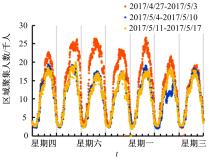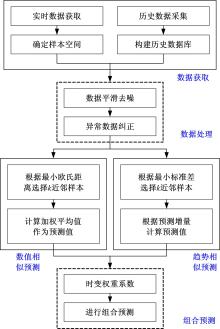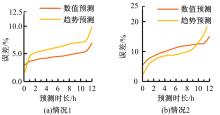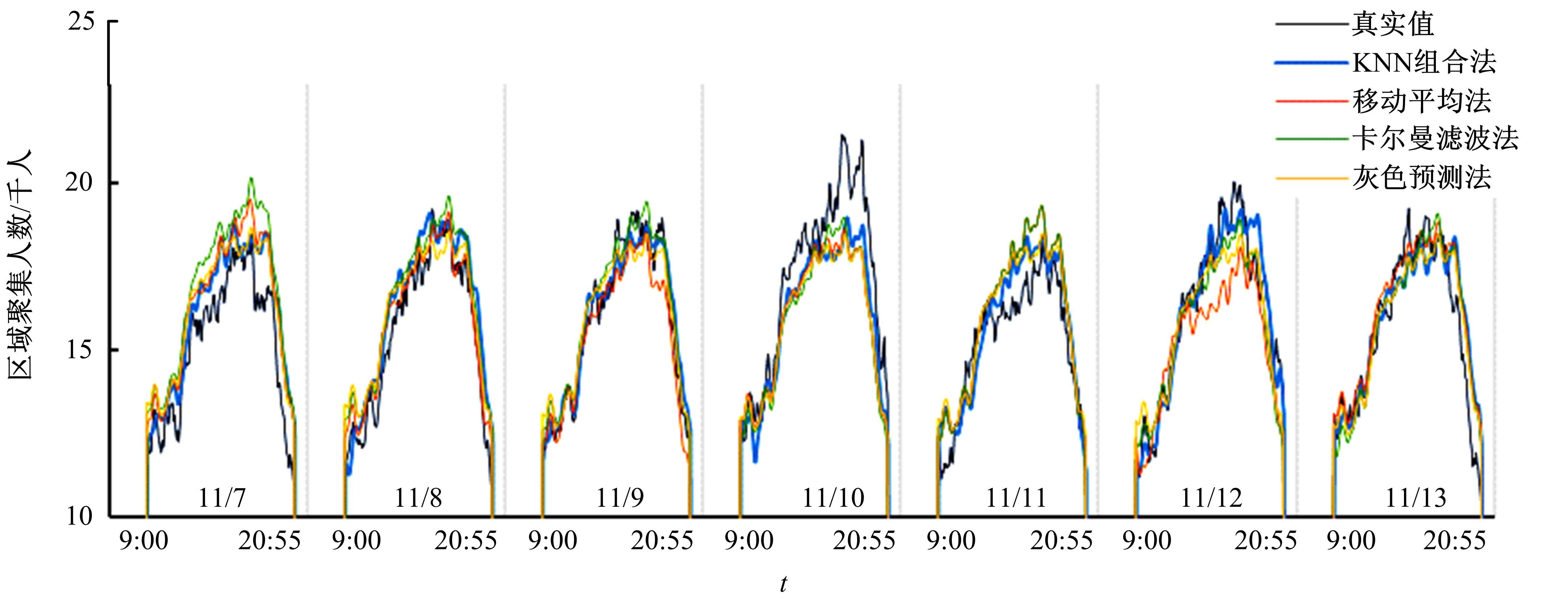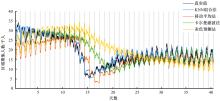吉林大学学报(工学版) ›› 2021, Vol. 51 ›› Issue (4): 1241-1250.doi: 10.13229/j.cnki.jdxbgxb20200288
• 交通运输工程·土木工程 • 上一篇
基于KNN回归的客运枢纽聚集人数组合预测方法
- 1.华南理工大学 土木与交通学院,广州 510640
2.现代城市交通技术江苏高校协同创新中心,南京 210096
3.深圳平安信息技术有限公司,广东 深圳 518052
Combination forecasting model for number of assembling passengers at transportation terminal based on KNN regression algorithm
Kai LU1,2( ),Wei WU1,Guan-rong LIN3(
),Wei WU1,Guan-rong LIN3( ),Xin TIAN1,Jian-min XU1,2
),Xin TIAN1,Jian-min XU1,2
- 1.School of Civil Engineering and Transportation,South China University of Technology,Guangzhou 510640,China
2.Jiangsu Province Collaborative Innovation Center of Modern Urban Traffic Technologies,Nanjing 210096,China
3.Shenzhen Ping An Information Technology Co. ,Ltd. ,Shenzhen 518052,China
摘要:
为精准预测客运枢纽聚集人数以形成合理科学的客运枢纽客流组织方案,提出了一种基于KNN回归算法的客运枢纽聚集人数组合预测方法。在分析客运枢纽客流聚集规律的基础上,以数值相似和趋势相似为原则运用KNN回归算法预测区域聚集人数,并综合考虑各自特点引入时变权重系数进行组合预测,解决了以往KNN回归预测模型所需历史数据量大和运行时间长等方面的不足。实例分析结果表明,本文方法在非节假日平均预测精度可达95%以上,在春运期间平均预测精度可达90%,均高于移动平均法、卡尔曼滤波法与灰色预测法。
中图分类号:
- U491
| 1 | 耿美君. 综合客运枢纽服务水平评价研究[D]. 长春: 吉林大学交通学院, 2009. |
| Geng Mei-jun. Research on LOS evaluation of comprehensive passenger transport terminal[D]. Changchun: College of Transportation,Jilin University, 2009. | |
| 2 | Cover T M, Hart P E. Nearest neighbor pattern classification[J]. IEEE Transactions on Information Theory, 1967, 13(1):21-27. |
| 3 | Yakowitz S. Nearest-neighbour methods for time series analysis[J]. Journal of Time Series Analysis,1987: 8(2): 235-247. |
| 4 | Davis G A, Nihan N. Nonparametric regression and short-term freeway traffic forecasting[J]. Journal of Transportation Engineering, 1991, 117(2): 178-188. |
| 5 | 张涛, 陈先, 谢美萍, 等. 基于K近邻非参数回归的短时交通流预测方法[J]. 系统工程理论与实践, 2010, 30(2):376-384. |
| Zhang Tao, Chen Xian, Xie Mei-ping, et al. KNN based nonparametric regression method for short-term traffic flow forecasting[J]. Systems Engineering-Theory & Practice, 2010, 30(2):376-384. | |
| 6 | 豆飞, 贾利民, 秦勇, 等. 铁路客运专线模糊k近邻客流预测模型[J]. 中南大学学报:自然科学版, 2014, 45(12):4422-4430. |
| Dou Fei, Jia Li-min, Qin Yong, et al. Fuzzy k-nearest neighbor passenger flow forecasting model of passenger dedicated line[J]. Journal of Central South University (Science and Technology), 2014, 45(12):4422-4430. | |
| 7 | 林培群, 陈丽甜, 雷永巍. 基于K近邻模式匹配的地铁客流量短时预测[J]. 华南理工大学学报:自然科学版, 2018, 46(1):50-57. |
| Lin Pei-qun, Chen Li-tian, Lei Yong-wei. Short-term forecasting of subway traffic based on K-nearest neighbour pattern matching[J]. Journal of South China University of Technology (Natural Science Edition), 2018, 46(1):50-57. | |
| 8 | 姚恩建, 周文华, 张永生. 城市轨道交通新站开通初期实时进出站客流量预测[J]. 中国铁道科学, 2018, 39(2):119-127. |
| Yao En-jian, Zhou Wen-hua, Zhang Yong-sheng. Real-time forecast of entrance and exit passenger flow for newly opened station of urban rail transit at initial stage[J]. China Railway Science, 2018, 39(2):119-127. | |
| 9 | 郇宁, 谢俏, 叶红霞, 等. 基于改进KNN算法的城轨进站客流实时预测[J]. 交通运输系统工程与信息, 2018, 18(5):121-128. |
| Huan Ning, Xie Qiao, Ye Hong-xia, et al. Real-time forecasting of urban rail transit ridership at the station level based on improved KNN algorithm[J]. Journal of Transportation Systems Engineering and Information Technology, 2018, 18(5):121-128. | |
| 10 | 邢志伟, 何川, 罗谦, 等. 基于双层K近邻算法航站楼短时客流量预测[J]. 北京航空航天大学学报, 2019, 45(1): 26-34 |
| Xing Zhi-wei, He Chuan, Luo Qian, et al. Terminal building short-term passenger flow forecast based on two-tier K-nearest neighbor algorithm[J]. Journal of Beijing University of Aeronautics and Astronautics, 2019,45(1):26-34. | |
| 11 | 赵亚伟, 陈艳晶. 多维时间序列的组合预测模型[J]. 中国科学院大学学报, 2016, 33(6):825-833. |
| Zhao Ya-wei, Chen Yan-jing. A combined prediction model for multi-dimensional time series[J]. Journal of University of Chinese Academy of Sciences, 2016, 33(6):825-833. | |
| 12 | 刘欣彤, 黄小龙, 谢秉磊. 基于SVM-KNN的降雨条件下短时公交客流预测[J]. 交通信息与安全, 2018, 36(5):117-123. |
| Liu Xin-tong, Huang Xiao-long, Xie Bing-lei. A model of short-term forecast of passenger flow of buses based on SVM-KNN under rainy conditions[J]. Journal of Transport Information and Safety, 2018, 36(5):117-123. | |
| 13 | 孟品超, 李学源, 贾洪飞, 等. 基于滑动平均法的轨道交通短时客流实时预测[J]. 吉林大学学报:工学版, 2018,48(2):448-453. |
| Meng Pin-chao, Li Xue-yuan, Jia Hong-fei, et al. Short-time rail transit passenger flow real-time prediction based on moving average[J]. Journal of Jilin University (Engineering and Technology Edition), 2018, 48(2): 448-453. |
| [1] | 彭博,张媛媛,王玉婷,唐聚,谢济铭. 基于自动编码机-分类器的视频交通状态自动识别[J]. 吉林大学学报(工学版), 2021, 51(3): 886-892. |
| [2] | 张健,吴坤润,杨敏,冉斌. 智能网联环境下交叉口双环自适应控制模型[J]. 吉林大学学报(工学版), 2021, 51(2): 541-548. |
| [3] | 王殿海,沈辛夷,罗小芹,金盛. 车均延误最小情况下的相位差优化方法[J]. 吉林大学学报(工学版), 2021, 51(2): 511-523. |
| [4] | 宋现敏,张明业,李振建,王鑫,张亚南. 动态公交专用道的设置及其仿真分析评价[J]. 吉林大学学报(工学版), 2020, 50(5): 1677-1686. |
| [5] | 贾洪飞,丁心茹,杨丽丽. 城市潮汐车道优化设计的双层规划模型[J]. 吉林大学学报(工学版), 2020, 50(2): 535-542. |
| [6] | 尹超英,邵春福,王晓全,熊志华. 考虑空间异质性的建成环境对通勤方式选择的影响[J]. 吉林大学学报(工学版), 2020, 50(2): 543-548. |
| [7] | 张大伟,祝海涛. 考虑行人差异性的人群疏散最优决策理论模型[J]. 吉林大学学报(工学版), 2020, 50(2): 549-556. |
| [8] | 常玉林,袁才鸿,孙超,张鹏. 基于改进元胞传输模型的城市路网实际阻抗计算方法[J]. 吉林大学学报(工学版), 2020, 50(1): 132-139. |
| [9] | 宗长富,文龙,何磊. 基于欧几里得聚类算法的三维激光雷达障碍物检测技术[J]. 吉林大学学报(工学版), 2020, 50(1): 107-113. |
| [10] | 隋振,姜源. 基于MIMO类脑情感学习回路的横-纵向综合控制驾驶员模型[J]. 吉林大学学报(工学版), 2020, 50(1): 140-146. |
| [11] | 别一鸣,姜凯,汤茹茹,王琳虹,熊昕宇. 考虑方案过渡影响的单点交通控制时段划分方法[J]. 吉林大学学报(工学版), 2019, 49(6): 1844-1851. |
| [12] | 谷远利, 张源, 芮小平, 陆文琦, 李萌, 王硕. 基于免疫算法优化LSSVM的短时交通流预测[J]. 吉林大学学报(工学版), 2019, 49(6): 1852-1857. |
| [13] | 程国柱, 冯思鹤, 冯天军. 占用车行道的路内停车泊位设置条件[J]. 吉林大学学报(工学版), 2019, 49(6): 1858-1864. |
| [14] | 龙海波,杨家其,赵学彧. 基于转运延误风险的多方式协同货运载运工具配置优化[J]. 吉林大学学报(工学版), 2019, 49(5): 1492-1499. |
| [15] | 别一鸣,汤茹茹,王运豪,文斌,冯天军,王琳虹. 信号交叉口进口车道饱和流率估计方法[J]. 吉林大学学报(工学版), 2019, 49(5): 1459-1464. |
|
||
